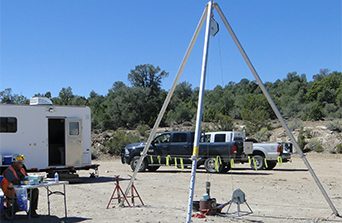Recent sampling results continue to show public water supplies are safe from the impacts of historic underground nuclear testing.
Recently published sampling results support scientific investigations that indicate public water supplies are safe from groundwater contaminated by historical underground nuclear testing at the Nevada National Security Site (NNSS). Groundwater samples collected in 2017 on federally-controlled land surrounding the NNSS and in nearby communities comply with safe drinking water safety limits for a variety of radioactive contaminants. Results of groundwater samples collected on the NNSS confirm that contamination is limited to locations near historic underground nuclear test sites. Detailed analytical results for the 34 groundwater samples collected can be reviewed in the Department of Energy Environmental Management (EM) Nevada Program annual Underground Test Area Annual Sampling Report, published in November 2018.
The validated laboratory results for the 34 samples collected from 27 wells (some at multiple depths) located on and near the NNSS are a key component of scientific research conducted to ensure the public is protected from accessing groundwater contaminated by historic underground nuclear testing.

Independent, State of Nevada-certified laboratories were used for analysis of the samples, which are tested to identify levels of general chemistry parameters, such as pH (acidity/alkalinity) and specific conductance (amount and mobility of ions that conduct electrical current). In addition, the samples are analyzed for 18 different metals (including lead), as well as for gamma emitting, gross alpha and beta, and the radioisotopes tritium, strontium-90, carbon-14, chlorine-36, technetium-99, iodine-129, and plutonium-238, -239 and -240. Specialized analyses for radioisotopes was also conducted by Lawrence Livermore National Laboratory to provide additional sample information that cannot be obtained by the commercial laboratory. This includes detecting radionuclides at lower levels which gives scientists a clearer picture of concentrations in groundwater.
A detailed quality assurance/quality control process is followed for the collection of groundwater samples that includes the collection of duplicate samples and various blanks (samples not from the wells), and the use of baseline samples (samples containing previously defined levels of a particular contaminant) to measure precision and accuracy. A complete description of all the processes implemented to further validate the integrity of sampling results is included in the report.
Groundwater samples are routinely collected by the EM Nevada Program as prescribed in the NNSS Integrated Groundwater Sampling Plan in conjunction with other NNSS water monitoring activities conducted in accordance with federal regulations. Additionally, groundwater is monitored by separate, independent programs conducted by Nye County and the Desert Research Institute’s Community Environmental Monitoring Program. The results of all NNSS environmental monitoring activities are published annually in the NNSS Environmental Report.
In the photos, groundwater samples are collected in September 2018 using a depth-discrete bailer at well ER-20-2 located on Pahute Mesa at the NNSS. Analyzed laboratory results of this sampling will be published in the 2018 Underground Test Area Annual Sampling Report and the 2018 NNSS Environmental Report.
Maps showing results of each well tested in 2017 appear as Figures 1-3 and 1-4 in the Sampling Report.

